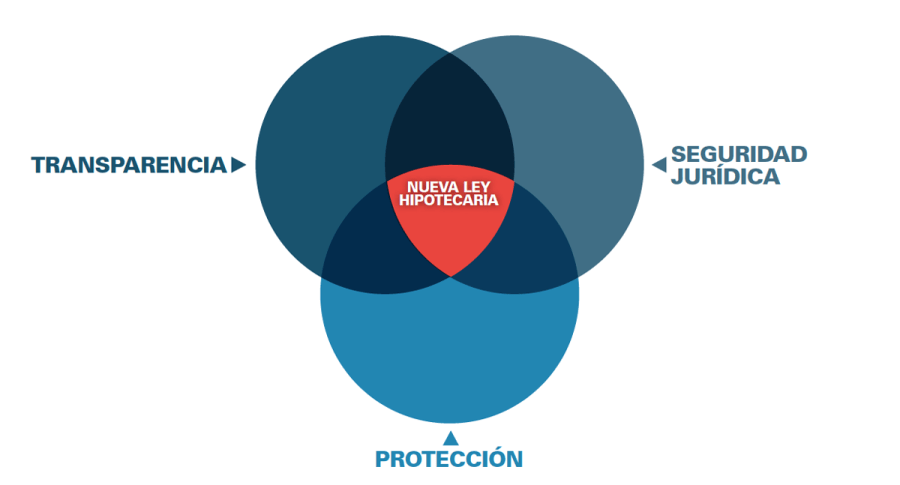
The key aspects of the new Mortgage Act
The new Mortgage Act that governs real estate credit agreements has three main objectives: to provide more consumer protection, make mortgage contracts more transparent and improve legal certainty in the financial system. All three are vital to ensure the mortgage market functions appropriately and to improve financial stability.
Popularly known as the "Mortgage Act", Spain's new law governing real estate credit contracts came into force on 16 June 2019, going through a lot of stages, procedures and amendments before finally being published in the Spanish gazette (BOE) on 16 March this year.
We should note that the main aim of this law was to transpose Europe's Mortgage Credit Directive passed in 2014 into Spanish legislation. But the Act also introduces additional measures to protect consumers and improve legal certainty, as well as including measures specific to the Spanish economy. The main aspects of the latter include extending the legal regime to cover not only consumers but all natural persons; a clearer allocation of mortgage costs and the prohibition of minimum interest clauses, issues which have been controversial in the past few years, as well as specific measures to promote fixed interest mortgages.

What are the key changes in the new Mortgage Act?
The main changes introduced by this new legislation, which are crucial for the mortgage market to function correctly, can be grouped into five blocks: transparency measures, measures related to the conduct and organisation of credit institutions, measures to limit early repayment charges, measures to promote conversion to fixed interest mortgages and, finally, criteria for mortgage foreclosures.
1 | TRANSPARENCY
The first block aims to make mortgage contracts more transparent. Specifically, it focuses on establishing a greater degree of regulation for the pre-contract phase, with the lender (bank) being required to provide detailed and binding1 information on the content of the contract, by means of:
- A European Standardised Information Sheet (ESIS) so that offers from different lenders and even from banks from different countries can be compared.
- A standardised warnings sheet (SWS) stating the clauses and reference interest rate used to establish the applicable interest rate, among other details.
- In the case of variable rate mortgages, an analysis of the evolution of the instalments under different interest rate scenarios.
It is also mandatory to visit a notary before the contract is signed to ensure the consumer (the buyer of the property) has received all the aforementioned information and understands the financial and legal obligations contained in the contract, this being recorded in a deed.
2 | CONDUCT OF THE BANK
The aim of the second block is to improve the rules of conduct and internal organisation of credit institutions. Specific training is required for personnel selling mortgages to ensure they have the necessary knowledge and skills, as well as setting limits regarding the remuneration policy for staff selling these credit agreements to avoid adverse incentives, and assessments are also required of the consumer's solvency before and over the lifetime of the credit to ensure their creditworthiness is assessed and not just the value of the property in question.
Tying practices (the obligation to take out other products as well as the mortgage)2 are also prohibited, although bundling is allowed (without any obligation) provided the quotes for such products are presented separately so that the cost of each one can be duly evaluated.
Finally, a clear framework has been established regarding the allocation of the costs associated with taking out a mortgage. Consumers pay any agency, notary and land registry fees while the lender is responsible for appraisal costs and additional copies of notarised documents, if required. However, many credit institutions are already opting to meet all the costs involved in order to reduce the risk of future legal actions.
3 | BANKING FEES
Thirdly, the Act lowers the mortgage fee for early repayment3 taken out after the Act came into force. One of the following options can be agreed for variable rate mortgages: a maximum charge4 of 0.25% of the capital repaid early during the first 3 years, or a charge of 0.15% during the first 5 years. With fixed interest mortgages, the maximum charge will be 2% during the first 10 years and 1.5% after that. This represents a substantial change to previous regulations as there was no legal limit for fixed rate contracts.
| New Act | |||
| Repayment period | Previous regulations | Option 1 | Option 2 |
| Under 3 years | 0,50 | 0,25 | 0,15 |
| Between 3 and 5 years | 0,50 | 0,00 | 0,15 |
| Over 5 years | 0,25 | 0,00 | 0,00 |
| New Act | |
| Under 10 years | 2,0 |
| Over 10 years | 1,5 |
Source: CaixaBank Research.
4 | CONVERSION TO FIXED RATE
The fourth pillar of the Act aims to encourage the conversion of variable rate mortgages to fixed rate in order to make households more financially stable in the face of potential interest rate hikes. Specifically, it establishes that, in such cases, the maximum charges for early repayment should be 0.15% of the outstanding capital during the first three years and 0% subsequently, significantly lower than the maximum charges in place before this legislative change.
One particularly relevant aspect of the new Act is that the new charges for converting from a variable to a fixed rate mortgage should be backdated; in other words, they apply to all existing mortgage contracts. In the current environment, with ultra-low interest rates, it is even more advantageous to incentivise this conversion in Spain since 87% of the mortgages are linked to the Euribor so that, in the expected scenario of higher interest rates, the financial burden of many Spanish households will increase. Fixed rate mortgages, which do not pass on the risk of interest rate variations to the borrower, keep mortgage instalments stable until the end of the contract and thereby help financial planning.
Adicionalmente, y en relación con la conversión de las hipotecas, el proyecto de ley facilita la conversión del crédito denominado en divisa extranjera a euros (o en la divisa en la que el prestatario percibe la mayoría de los ingresos), lo que proporciona protección frente al riesgo de tipo de cambio.
| Previous regulations | New Act | |
| Under 3 years | 0,50 | 0,15 |
| Between 3 and 5 years | 0,50 | 0,00 |
| Over 5 years | 0,25 |
Source: CaixaBank Research.
5 | MORTGAGE FORECLOSURE
The last pillar of the Act establishes tougher criteria for creditors to begin foreclosure proceedings. During the first half of a credit's lifetime, over 3% of the capital granted must be defaulted or more than 12 monthly instalments. During the second half of the credit's lifetime, this default must be over 7% or more than 15 instalments. This change in the law, applicable to both new and existing mortgages, establishes a single criterion that helps to strengthen the legal certainty of mortgage contracts. Additionally, late payment interest will be the rate agreed in the contract plus 3 points during the late payment period, calculated on the outstanding capital.
- 1During the period agreed until the contract is signed, which must be at least 10 days (in Catalonia 14 days).
- 2Except for insurance policies covering repayment of the loan or damages to the mortgaged property.
- 3This charge compensates the credit institution for any losses incurred due to early repayment.
What impact will the new Act have on the mortgage market?
In general terms, the new Act will have a positive effect as it reinforces legal certainty and therefore helps the mortgage market to work properly.
And the new law?
The new Act will help the mortgage market to perform better
Specifically, the changes introduced by the Mortgage Act foster greater transparency and reduce the unequal balance of information between the different parties. They also clarify some issues that were either not covered by the previous law or ambiguous and that have resulted in conflict and numerous legal proceedings, such as the criteria for mortgage foreclosure and who is responsible for mortgage costs. Legal uncertainty is damaging for both banks and their customers as this makes it difficult to have a precise idea of the costs and risks involved in the operation and can end up limiting the supply or making transactions more expensive. Consequently, the improved legal certainty and greater transparency help the mortgage market to perform better and promote credit activity.
Standardising pre-contract documentation at a European level and greater transparency should also encourage competition. However, more competition between countries is unlikely because of the large number of different legal aspects and frameworks that make it difficult to achieve a truly pan-European mortgage market at present.
The Mortgage Act encourages people to take out or convert to fixed interest mortgages. As we have already noted, this kind of contract protects households from interest rate fluctuations and should therefore make the economy more financially stable. However, the limits established for charges on the early repayment of fixed rate mortgages might reduce the supply or end up making such contracts more expensive. Given that banks assume the interest rate risk, at times when interest rates are below the rate established in the contract, should some of the outstanding capital be repaid early the creditor would incur a financial loss since the funds repaid could not be reinvested in an asset providing a similar return. As can be seen in the next chart, in most cases the bank's financial loss is much higher than the maximum charge established by law of 2% of the repaid capital in the first 10 years and 1.5% subsequently.
The minimum requirements to be able to foreclose on a mortgage5 also delay the recovery of the unpaid debt on a defaulted loan, increasing foreclosure costs. This could result in tougher credit conditions for those customers with a higher risk profile.
In conclusion, the new Mortgage Act will clearly help the mortgage market to function better since it increases consumer protection, reinforces transparency and strengthens the legal certainty of the financial system. Nevertheless, in the short term some of the new measures may result in tougher criteria to grant credit to those people with a higher risk profile. Neither is it clear whether the measures favouring conversions from variable to fixed mortgages are attractive enough to promote this kind of contract.
| Early repayment period | |||||||
| 1 year | 5 years | 10 years | 15 years | 20 years | 25 years | ||
Spread between the contract and market interest rate (percentage points) | 0,25 | 3,6 | 2,9 | 2,2 | 1,5 | 1,0 | 0,5 |
| 0,50 | 7,3 | 6,0 | 4,5 | 3,2 | 2,0 | 1,0 | |
| 0,75 | 11,2 | 9,2 | 7,0 | 5,0 | 3,2 | 1,6 | |
| 1,00 | 15,2 | 12,6 | 9,6 | 7,0 | 4,5 | 2,3 | |
| 1,25 | 19,3 | 16,2 | 12,5 | 9,1 | 6,0 | 3,1 | |
| 1,50 | 23,7 | 19,9 | 15,6 | 11,4 | 7,6 | 4,0 | |
Financial loss less than the maximum charge Financial loss more than the maximum charge
Example: If the capital is repaid 5 years after the mortgage is taken out and the market interest rate has fallen by 1 percentage point, the bank loses 12.6% of the repaid capital, much more than the maximum charge of 2% established by the Act. Note: Assuming a 30-year mortgage at a 2% interest rate. However, the differences with other interest rates are minimal. The relevant variables are the spread between the market interest rate and the point in the credit's lifetime that the early repayment takes place. Future losses are shown at their present value. Source: CaixaBank Research.
| Average 2000-2007 | Average 2008-2014 | Average 2015-2017 | Data 2018 | Forecast 20191 | Forecast 20201 | Trend2 | |
| Economic activity indicators | |||||||
| GDP | 3,8 | -1,0 | 3,3 | 2,6 | 2,3 | 1,9 | |
| GVA construction | 2,7 | -8,0 | 4,8 | 7,6 | 6,0 | 4,0 | |
| Investment in construction | 6,2 | -8,6 | 3,1 | 6,2 | 3,6 | 2,9 | |
| New building permits (thousands) | 642 | 94 | 65 | 101 | 120 | 130 | |
| New building permits | 3.9 | -30,5 | 32,5 | 24,7 | 19,1 | 8,3 | |
| Certificates of final completion (thousands) | 482 | 230 | 47 | 64 | 90 | 110 | |
| Certificates of final completion | 8,3 | -31,2 | 5,3 | 17,8 | 39,9 | 22,2 | |
| Synthetic indicator for construction | 3,1 | -8,4 | 6,2 | 7,9 | - | - | |
| Confidence in the construction sector (level) | 13,1 | -41,8 | -30,6 | -4,6 | |||
| Labour market | |||||||
| Total workers registered with Social Security | 3,5 | -2,1 | 3,3 | 3,1 | 2,8 | 2,2 | |
| Registered workers in construction | 6,1 | -13,0 | 4,5 | 6,7 | 5,8 | 2,7 | |
| Construction of buildings | - | -14,4 | 5,7 | 8,0 | 8,0 | 2,8 | |
| Civil engineering | - | -16,4 | 0,5 | 2,7 | 3,6 | 2,1 | |
| Specialised construction | - | -8.9 | 4,1 | 4,9 | 4,6 | 2,7 | |
| Registered workers in real estate activities | 10,3 | 2,1 | 7,0 | 6,2 | 5,8 | 2,5 | |
| Total employees (LFS) | 4,1 | -2,4 | 2,8 | 2,7 | 2,4 | 1,9 | |
| Temporary employment rate in construction (%) | 57,3 | 39,6 | 42,0 | 40,5 | 40,0 | 40,0 | |
| Unemployment rate in construction (%) | 7,5 | 22,8 | 14,2 | 10,5 | 8,3 | 7,5 | |
| Demand for housing | |||||||
| Sales3 (thousands) | 886 | 388 | 410 | 516 | 542 | 561 | |
| Sales3 | -0,1 | -11,9 | 13,6 | 10,3 | 5,0 | 3,5 | |
| New housing3 | 12,1 | -13,6 | -10,9 | -6,0 | - | - | - |
| Second-hand housing3 | -7,8 | -10,8 | 24,1 | -5,9 | - | - | - |
| Foreign sales4 | -22,1 | -6,3 | 13,4 | 3,0 | 2,0 | 1,1 | |
| Second home sales5 | -7,6 | -9,8 | 7,0 | 10,7 | 7,0 | 5,5 | |
| Prices | |||||||
| House prices (Min. Public Works) | 12,9 | -4,8 | 1,8 | 3,4 | 4,4 | 4,4 | |
| House prices (INE) | - | -6,1 | 4,8 | -6,7 | 5,7 | 4,8 | |
| Land prices | 17,5 | -8,8 | 3,4 | -1,6 | 0,4 | 4,2 | |
| CPI rent | 3,2 | 1,8 | 0,4 | 1,7 | - | - | - |
| Affordability ratios | |||||||
| House prices (% gross disposable income) | 6,5 | 7,4 | 6,7 | 7,4 | 7,5 | 7,6 | |
| Theoretical burden (% gross disposable income) | 35,1 | 37,5 | 30,5 | 32,3 | 32,4 | 33,0 | |
| Return on rent (%) | 4,5 | 3,5 | 4,4 | 4,1 | - | - | |
| Financing6 | |||||||
| Number of mortgages | 5,8 | -22,7 | 15,3 | 10,6 | 16,0 | - | |
| Outstanding balance of credit to purchase housing | 23,0 | -0,1 | -3,7 | -1,9 | -1,2 | - | |
| New loans housing | -3,0 | -21,4 | 12,9 | 10,8 | 7,4 | - | |
| Outstanding balance of credit for property development | 23,0 | -0,1 | -3,7 | -1,9 | -1,2 | - | |
| NPL ratio of credit for housing (%) | 37,3 | -10,1 | -11,1 | -17,1 | - | - | |
| NPL ratio of credit for property development (%) | 0,4 | 20,0 | 26,2 | 10,9 | - | - | |
Notes: 1. Forecasts at 31 May 2019. 2. A sun indicates growth above the 2015-2018 average less 1/4 standard deviation; a sun with a cloud indicates growth above the 2015-2018 average less a standard deviation; a cloud indicates negative growth or growth above the 2015-2018 average less 1.5 standard deviations; rain indicates growth below the 2015-2018 average less 1.5 standard deviations. 3. The 2000-2007 average for house sales corresponds to the period 2004-2007 and the data come from the Ministry of Public Works. National Statistics Institute’s sales figures as from 2007. 4. Foreign sales according to the Ministry of Public Works. 5. Sales of second homes are estimated based on the sales carried out in a different province than the buyer’s residence. 6. The Financing data in the column "Forecast 2019" correspond to cumulative data up to the latest data available for 2019.
Source: CaixaBank Research, based on data from the National Statistics Institute (INE), Ministry of Public Works, Ministry of Public Works, Ministry of Employment and Social Security and Bank of Spain.
- 5Under the previous law, clauses tended to establish a period of three months.



